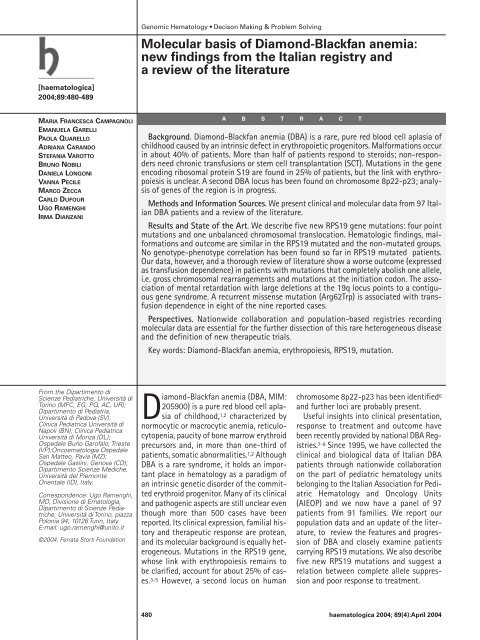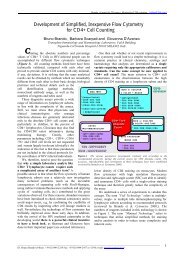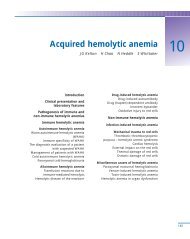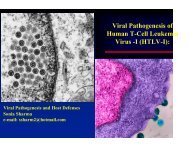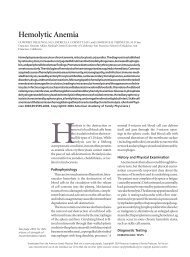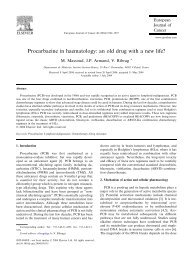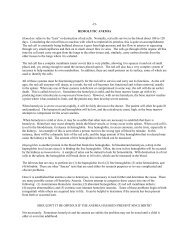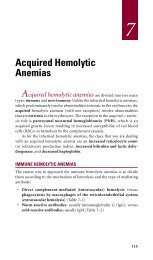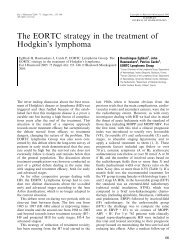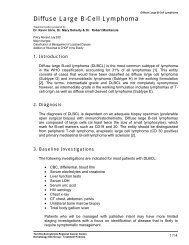Molecular basis of Diamond-Blackfan anemia: new findings from the ...
Molecular basis of Diamond-Blackfan anemia: new findings from the ...
Molecular basis of Diamond-Blackfan anemia: new findings from the ...
Create successful ePaper yourself
Turn your PDF publications into a flip-book with our unique Google optimized e-Paper software.
Genomic Hematology • Decison Making & Problem Solving<strong>Molecular</strong> <strong>basis</strong> <strong>of</strong> <strong>Diamond</strong>-<strong>Blackfan</strong> <strong>anemia</strong>:<strong>new</strong> <strong>findings</strong> <strong>from</strong> <strong>the</strong> Italian registry anda review <strong>of</strong> <strong>the</strong> literature[haematologica]2004;89:480-489MARIA FRANCESCA CAMPAGNOLIEMANUELA GARELLIPAOLA QUARELLOADRIANA CARANDOSTEFANIA VAROTTOBRUNO NOBILIDANIELA LONGONIVANNA PECILEMARCO ZECCACARLO DUFOURUGO RAMENGHIIRMA DIANZANIA B S T R A C TBackground. <strong>Diamond</strong>-<strong>Blackfan</strong> <strong>anemia</strong> (DBA) is a rare, pure red blood cell aplasia <strong>of</strong>childhood caused by an intrinsic defect in erythropoietic progenitors. Malformations occurin about 40% <strong>of</strong> patients. More than half <strong>of</strong> patients respond to steroids; non-respondersneed chronic transfusions or stem cell transplantation (SCT). Mutations in <strong>the</strong> geneencoding ribosomal protein S19 are found in 25% <strong>of</strong> patients, but <strong>the</strong> link with erythropoiesisis unclear. A second DBA locus has been found on chromosome 8p22-p23; analysis<strong>of</strong> genes <strong>of</strong> <strong>the</strong> region is in progress.Methods and Information Sources. We present clinical and molecular data <strong>from</strong> 97 ItalianDBA patients and a review <strong>of</strong> <strong>the</strong> literature.Results and State <strong>of</strong> <strong>the</strong> Art. We describe five <strong>new</strong> RPS19 gene mutations: four pointmutations and one unbalanced chromosomal translocation. Hematologic <strong>findings</strong>, malformationsand outcome are similar in <strong>the</strong> RPS19 mutated and <strong>the</strong> non-mutated groups.No genotype-phenotype correlation has been found so far in RPS19 mutated patients.Our data, however, and a thorough review <strong>of</strong> literature show a worse outcome (expressedas transfusion dependence) in patients with mutations that completely abolish one allele,i.e. gross chromosomal rearrangements and mutations at <strong>the</strong> initiation codon. The association<strong>of</strong> mental retardation with large deletions at <strong>the</strong> 19q locus points to a contiguousgene syndrome. A recurrent missense mutation (Arg62Trp) is associated with transfusiondependence in eight <strong>of</strong> <strong>the</strong> nine reported cases.Perspectives. Nationwide collaboration and population-based registries recordingmolecular data are essential for <strong>the</strong> fur<strong>the</strong>r dissection <strong>of</strong> this rare heterogeneous diseaseand <strong>the</strong> definition <strong>of</strong> <strong>new</strong> <strong>the</strong>rapeutic trials.Key words: <strong>Diamond</strong>-<strong>Blackfan</strong> <strong>anemia</strong>, erythropoiesis, RPS19, mutation.From <strong>the</strong> Dipartimento diScienze Pediatriche, Università diTorino (MFC, EG, PQ, AC, UR);Dipartimento di Pediatria,Università di Padova (SV);Clinica Pediatrica Università diNapoli (BN); Clinica PediatricaUniversità di Monza (DL);Ospedale Burlo Gar<strong>of</strong>alo, Trieste(VP);Oncoematologia OspedaleSan Matteo, Pavia (MZ);Ospedale Gaslini, Genova (CD);Dipartimento Scienze Mediche,Università del PiemonteOrientale (ID), Italy.Correspondence: Ugo Ramenghi,MD, Divisione di Ematologia,Dipartimento di Scienze Pediatriche,Università di Torino, piazzaPolonia 94, 10126 Turin, Italy.E-mail: ugo.ramenghi@unito.it©2004, Ferrata Storti Foundation<strong>Diamond</strong>-<strong>Blackfan</strong> <strong>anemia</strong> (DBA, MIM:205900) is a pure red blood cell aplasia<strong>of</strong> childhood, 1,2 characterized bynormocytic or macrocytic <strong>anemia</strong>, reticulocytopenia,paucity <strong>of</strong> bone marrow erythroidprecursors and, in more than one-third <strong>of</strong>patients, somatic abnormalities. 1,2 AlthoughDBA is a rare syndrome, it holds an importantplace in hematology as a paradigm <strong>of</strong>an intrinsic genetic disorder <strong>of</strong> <strong>the</strong> committederythroid progenitor. Many <strong>of</strong> its clinicaland pathogenic aspects are still unclear eventhough more than 500 cases have beenreported. Its clinical expression, familial historyand <strong>the</strong>rapeutic response are protean,and its molecular background is equally heterogeneous.Mutations in <strong>the</strong> RPS19 gene,whose link with erythropoiesis remains tobe clarified, account for about 25% <strong>of</strong> cases.3-5 However, a second locus on humanchromosome 8p22-p23 has been identified 6and fur<strong>the</strong>r loci are probably present.Useful insights into clinical presentation,response to treatment and outcome havebeen recently provided by national DBA Registries.7-9 Since 1995, we have collected <strong>the</strong>clinical and biological data <strong>of</strong> Italian DBApatients through nationwide collaborationon <strong>the</strong> part <strong>of</strong> pediatric hematology unitsbelonging to <strong>the</strong> Italian Association for PediatricHematology and Oncology Units(AIEOP) and we now have a panel <strong>of</strong> 97patients <strong>from</strong> 91 families. We report ourpopulation data and an update <strong>of</strong> <strong>the</strong> literature,to review <strong>the</strong> features and progression<strong>of</strong> DBA and closely examine patientscarrying RPS19 mutations. We also describefive <strong>new</strong> RPS19 mutations and suggest arelation between complete allele suppressionand poor response to treatment.480haematologica 2004; 89(4):April 2004
<strong>Diamond</strong>-<strong>Blackfan</strong> <strong>anemia</strong> in <strong>the</strong> Italian populationEpidemiology and inheritanceThe incidence <strong>of</strong> DBA is estimated to range <strong>from</strong> 5 to10 cases per million live births in Europe, with <strong>the</strong> lowestvalues in <strong>the</strong> UK and <strong>the</strong> highest in Nor<strong>the</strong>rnEurope; 7,8,10 <strong>the</strong> incidence in Italy is about 6.5 cases permillion live births. 11 The clustering <strong>of</strong> birth monthsobserved by Ball et al. in 1996, which suggested virusrelatedseasonality, 7 has not been confirmed by subsequentpopulation studies. 8,11 The sex ratio is about 1:1.The vast majority <strong>of</strong> cases are sporadic; 12,13 familiaritywith ei<strong>the</strong>r an autosomal dominant or, seldom, arecessive pattern <strong>of</strong> inheritance is reported in 10%-20% <strong>of</strong> patients. 12,13 In our series <strong>of</strong> 97 Italian patients,family inheritance is apparent in 16 families out <strong>of</strong> 91(17.5%), with an autosomal dominant pattern in tenand an autosomal recessive pattern, defined as <strong>the</strong>presence <strong>of</strong> DBA siblings <strong>from</strong> unaffected consanguineousparents, in six. The male: female ratio is1:1.04.Clinical presentationTable 1. Diagnostic criteria for DBA (accepted by <strong>the</strong>DBA working group <strong>of</strong> <strong>the</strong> European Society for PaediatricHaematology and Immunology, ESPHI).• normochromic, <strong>of</strong>ten macrocytic <strong>anemia</strong> developing in <strong>the</strong>first year <strong>of</strong> life• pr<strong>of</strong>ound reticulocytopenia• normocellular bone marrow with selective deficiency <strong>of</strong>erythroid precursors• normal or slightly reduced leukocyte count• normal or slightly increased platelet countHematologic featuresAll patients with DBA are, by definition, anemic. Anemiais already evident at birth in 25% <strong>of</strong> cases; inalmost all patients (95% in our series) presentation isin <strong>the</strong> first year <strong>of</strong> life. 12,13 Red blood cells are usuallymacrocytic; reticulocyte counts are decreased or zero.In our own series, hemoglobin (Hb) at diagnosis ranged<strong>from</strong> 2.3 to 10.8 g/dL (mean; 5.7±2.1 g/dL) and meancell volume (MCV) ranged <strong>from</strong> 67.3 to 111 fL (mean:93±9.9 fL).The o<strong>the</strong>r hematologic lineages are not involved as arule, though slightly abnormal low leukocyte and highplatelet counts have been reported at diagnosis. 14,15Bone marrow aspirates demonstrate isolated erythroblastopenia(erythroblasts
M.F. Campagnoli et al.<strong>of</strong> erythroid colonies, partially corrected by addition <strong>of</strong>SCF, make <strong>the</strong>se two parameters, not included in <strong>the</strong>major diagnostic criteria, useful in <strong>the</strong> diagnosis <strong>of</strong> DBA.TherapySteroid treatmentMore than 50% <strong>of</strong> patients respond to standardsteroid <strong>the</strong>rapy (prednisone 2 mg/kg/die orally), andsome achieve long periods <strong>of</strong> remission. 12,18 However,many responders become steroid-dependent and mayexperience steroid-related complications. High dosemethylprednisolone (30-100 mg/kg/die) has been proposedas a second-line treatment in non-responders;19,20,21 four <strong>of</strong> our ten patients treated with highdose steroids initially responded, but only one had a persistentlymodified status and subsequently achievedhematologic remission.Willig et al. reported that steroid resistance is not adefinitive feature, as some patients recover sensitivity tosteroids during <strong>the</strong> course <strong>of</strong> <strong>the</strong> disease; 8 <strong>the</strong>y <strong>the</strong>reforesuggest <strong>the</strong> repetition <strong>of</strong> standard doses before highdoses are considered.How glucocorticoids stimulate erythropoiesis isunknown. The steroid response seems not to be mediatedby <strong>the</strong> immunosuppressive activity <strong>of</strong> <strong>the</strong>se drugs,because most o<strong>the</strong>r immunosuppressants are ineffectivein DBA. Since steroids are transcription regulators,<strong>the</strong>y are thought to influence <strong>the</strong> expression <strong>of</strong>cytokines, growth factors and <strong>the</strong>ir receptors.O<strong>the</strong>r treatmentsTherapeutic options in steroid-resistant patients arechronic red cell transfusions or allogeneic stem celltransplantation (SCT). 22-24 Androgens, 13 growth factors(interleukin-3 and erythropoietin) 25,26 and cyclosporineA (CSA) 27,28 have occasionally been used, but eventuallydiscontinued on account <strong>of</strong> adverse effects or lowefficacy. The recent report that metoclopramide maymodulate erythropoiesis in DBA by increasing prolactinlevels has yet to be validated by larger studies. 29 Thrombopoietin(TPO) stimulates <strong>the</strong> growth <strong>of</strong> BFU-E <strong>from</strong>DBA patients in vitro, but its pharmacological effect hasnot been evaluated. 30Three <strong>of</strong> our patients underwent treatment with CSA,seven with interleukin-3, one with androgens and twowith metoclopramide. Only two subjects treated withinterleukin-3 achieved an initial response, but had tointerrupt <strong>the</strong> treatment due to side effects. Metoclopramidewas ineffective.Stem cell transplantation (SCT) has been explored asan alternative to chronic transfusions since 1976. 31 Morethan 70 DBA patients have undergone SCT so far 8,32,33with an overall survival <strong>of</strong> about 85% at three years<strong>from</strong> sibling donors in more recent reports. 8,33 The candidatesibling donor for a DBA patient with mutation inRPS19 should undergo molecular analysis to rule out<strong>the</strong> presence <strong>of</strong> <strong>the</strong> mutation, which could be due to agerminal mosaicism in an unaffected parent. Alternativedonor transplantation (MUD, matched unrelated donor)has been reported to be burdened by high mortality, withan actuarial survival <strong>of</strong> about 15% at 62 months, 33 butthis poor outcome was not confirmed in our recentexperience, probably due to <strong>the</strong> improvement <strong>of</strong> both <strong>the</strong>conditioning regimen and HLA matching <strong>of</strong> <strong>the</strong> donors.Five successful cord blood transplants (CBT) have beenreported in DBA patients, although <strong>the</strong> indications forsuch transplants for bone marrow failure syndromes arestill controversial. 34-38SCT was performed in twelve <strong>of</strong> our patients (5 <strong>from</strong>a sibling donor, 4 MUD and 3 CBT). No significant differencein <strong>the</strong> outcome was observed between transplants<strong>from</strong> a sibling and MUD (F. Locatelli, personalcommunication).Gene <strong>the</strong>rapyIdentification <strong>of</strong> RPS19 as <strong>the</strong> first causal gene forDBA opened <strong>the</strong> road to gene transfer experiments.Hamaguchi et al. have demonstrated that forced expression<strong>of</strong> RPS19 in CD34 + cells <strong>from</strong> four RPS19-deficientDBA patients using oncoretroviral vectors significantlyenhanced erythroid colony formation in vitro, <strong>the</strong>rebyimplying that early erythroid development can beimproved by gene transfer. 39 However, since erythroidcolony formation varies <strong>from</strong> one patient to ano<strong>the</strong>r, <strong>the</strong>effects <strong>of</strong> RPS19 gene transfer may well be different.Gene <strong>the</strong>rapy for RPS19-deficient DBA seems thus feasibleand promising, but fur<strong>the</strong>r studies are necessary.Follow-upResponse to treatment and outcomeAter and Young have summarized long-term survivalfor more than 500 DBA patients reported in <strong>the</strong> literature.13 The median survival age for <strong>the</strong> patients reportedin <strong>the</strong> past ten years is 54 years, with a significantimprovement <strong>of</strong> survival in steroid-responsive versustransfusion-dependent patients. Of 76 patients followedover a 60-year period in Boston, one-third (n=24)were in remission <strong>of</strong>f treatment and <strong>the</strong> remaining twothirdswere dependent on ei<strong>the</strong>r transfusions (n=36) orsteroids (n=13); three had been lost to follow-up. 40In our series, 85 patients were available for long-termevaluation (mean follow-up: 150±95 months). Their statusat <strong>the</strong> time <strong>of</strong> <strong>the</strong> study is reported in Figure 1:61,2% were undergoing treatment (two-thirds weretransfusion-dependent and one-third steroid-dependent)and 30,6% were free <strong>from</strong> treatment, one-third482haematologica 2004; 89(4):April 2004
<strong>Diamond</strong>-<strong>Blackfan</strong> <strong>anemia</strong> in <strong>the</strong> Italian populationafter SCT. Seven patients (8.2%) had died, four <strong>from</strong> SCTrelatedcomplications and three <strong>from</strong> o<strong>the</strong>r causes.A number <strong>of</strong> patients, though, experience spontaneousremission. 12,40 Hematologic remission wasachieved by 21% <strong>of</strong> our patients (excluding patientswho underwent SCT) a median <strong>of</strong> 14.5 months afterdiagnosis (range: 7-82 months). Fourteen patients wereinitially steroid responders and two had never requiredany treatment due to mild <strong>anemia</strong>; only two were transfusion-dependent,suggesting that steroid-resistantpatients have a very low chance <strong>of</strong> remission.Cytopenia and malignanciesNeutropenia and/or thrombocytopenia are notuncommon and occurred in 13 patients (15%) in ourseries. The pathogenesis <strong>of</strong> cytopenia is unclear. Severalreports suggest that <strong>the</strong> hematopoietic defect insevere DBA may not be confined to <strong>the</strong> erythroid lineage.Giri et al. reported that long-term culture-initiatingcells (LTC-IC) are quantitatively equivalent in DBApatients and normal controls, but <strong>the</strong> average clonogeniccell output per LTC-IC is significantly lower inDBA patients. 15 Similarly, Santucci et al. demonstratedthat <strong>the</strong> ability <strong>of</strong> <strong>the</strong> enriched CD34 + bone marrow cellfraction to proliferate and differentiate in vitro along<strong>the</strong> granulo-macrophage pathway is impaired in someDBA patients. 41 Hamaguchi et al. reported both significantreduction <strong>of</strong> <strong>the</strong> proliferative recruitment <strong>of</strong>CD34 + CD38 − hematopoietic progenitors in DBA patientsand significant improvement <strong>of</strong> <strong>the</strong>ir proliferativecapacity in RPS19-deficient DBA patients followingenforced expression <strong>of</strong> RPS19 with lentiviral vectors. 42Conversely, we have documented <strong>the</strong> immune pathogenesis<strong>of</strong> cytopenia in three patients, only one <strong>of</strong>whom was transfusion-dependent. DBA, like o<strong>the</strong>r bonemarrow failure syndromes such as dyskeratosis congenita(MIM:305000), may thus predispose to autoimmuneprocesses, even in <strong>the</strong> absence <strong>of</strong> heavy exogenousantigenic stimulation, and cytopenia may be dueto increased peripheral destruction <strong>of</strong> blood cellsinstead <strong>of</strong> reduced production. The two hypo<strong>the</strong>ses arenot mutually exclusive.Like o<strong>the</strong>r marrow failure syndromes, DBA is associatedwith a slightly increased risk <strong>of</strong> cancer. Malignancieshave been reported in 29 patients: 8,13,23,43-56 15hematopoietic neoplasms, primarily acute non-lymphocyticleukemias and myelodysplastic syndromes, 5osteogenic sarcomas and 9 cases <strong>of</strong> o<strong>the</strong>r solid tumors(hepatocellular carcinoma, gastric and colorectal carcinomas,breast cancer, melanoma and rare sarcomas).No malignancies were observed in our series.Several reports suggest that iron overload, androgenuse and immunosuppression secondary to steroid <strong>the</strong>rapypredispose DBA patients to malignancies. 44,45,49 Fur<strong>the</strong>rmore,myeloid malignancies are not unexpected, asDBA primarily involves <strong>the</strong> intrinsic hematopoietic progenitor.Conversely, <strong>the</strong> pathogenesis <strong>of</strong> osteogenic sarcomais difficult to explain; since this malignancy hasbeen observed in o<strong>the</strong>r genetic disorders, such as hereditaryretinoblastoma and Li-Fraumeni syndrome, it hasbeen suggested that DBA could be added to <strong>the</strong> list <strong>of</strong>syndromes predisposing to osteogenic sarcoma. 56GeneticsRPS19 geneIn 1997, identification <strong>of</strong> a balanced reciprocaltranslocation t(X;19)(p21;q13) in a sporadic case <strong>of</strong> DBAsuggested <strong>the</strong> presence <strong>of</strong> a DBA locus on chromosome19q13 57 and this suggestion was fur<strong>the</strong>r supported bylinkage studies in multiplex families 58 and by <strong>the</strong> identification<strong>of</strong> microdeletions spanning this region insome DBA patients. 59 Subsequent cloning <strong>of</strong> <strong>the</strong> 19q13breakpoint <strong>from</strong> <strong>the</strong> DBA patient with t(X;19) revealedthat <strong>the</strong> gene responsible for <strong>the</strong> disease was RPS19. 60This gene encodes for <strong>the</strong> ribosomal protein (rp) S19,associated with <strong>the</strong> ribosomal 40S subunit, and isespressed ubiquitously in hematopoietic and nonhematopoietictissues. The involvement <strong>of</strong> RPS19 inDBA was confirmed by molecular analysis in a largergroup <strong>of</strong> patients: 3,60 mutations in <strong>the</strong> RPS19 gene wereidentified in approximately 25% <strong>of</strong> DBA subjects. Mutationsconstantly affect only one allele, and, in multiplexfamilies, co-segregate with <strong>the</strong> DBA phenotype in consecutivegenerations with an autosomal dominantmode <strong>of</strong> transmission.More than sixty RPS19 mutations, scattered over <strong>the</strong>whole gene, have now been described. 3-5,59,61,62 Missense,nonsense, insertions, deletions and splice sitedefects have been found (Table 2). Eleven mutationsrecur in more than one patient; <strong>the</strong> particularly frequentones are <strong>the</strong> nonsense mutation Arg94Stop (6patients) and <strong>the</strong> missense mutations Arg62Trp (9patients) and Arg56Gln (5 patients). A hot spot <strong>of</strong> missensemutations was identified between codons 52 and62 (5 mutations in 18/60 overall patients), a highly conservedregion likely to have a critical role in RPS19 function.3RPS19 carried a mutation in 24.7% <strong>of</strong> our families. In<strong>the</strong> present study, which includes 25 <strong>new</strong> patients, wedescribe five <strong>new</strong> sporadic mutations: a chromosomaltranslocation with a wide deletion and four point mutations.In <strong>the</strong> first patient, a female with translocationt(1;19)(p32; q13), microsatellite analysis demonstrateda deletion on 19q13 which included markers CEA andPG1 flanking <strong>the</strong> RPS19 gene, indicating loss <strong>of</strong> <strong>the</strong>paternal RPS19 allele. Because paternal D19S197 andLIPE markers were conserved, <strong>the</strong> deletion was predictedto span about 1 Mb. The patient presented both DBAhaematologica 2004; 89(4):April 2004483
M.F. Campagnoli et al.Table 2. Mutations in RPS19 gene.Genomic DNA Exon/Intron Expected Protein Number <strong>of</strong> ReferencesMutation Alteration families (*)Nonsense mutations31 C→T ex 2 Gln11Stop 2 Willig 1999, Proust 200334 C→T ex 2 Gln12Stop 2 Willig 199999 G→A ex 3 Trp33Stop 2 Willig 1999, Matsson 1999144 C→A ex 3 Tyr48Stop 1 Willig 1999156 G→A ex 3 Trp52Stop 1 Willig 1999166 C→T ex 3 Arg56Stop 2 Willig 1999, Proust 2003280 C→T ex 4 Arg94Stop 6 Draptchinskaia 1999, Willig 1999,Matsson 1999, Proust 2003382 C→T ex 5 Glun128Stop 1 Proust 2003Missense mutations1 A→G ex 2 Met1Val 1 Draptchinskaia 1999protein level unknown3 G→C ex 2 Met1Ileu 1 Ramenghi 2000protein level unknown3 G→T ex 2 Met1Ileu 1 Ramenghi 2000protein level unknown3 G→A ex 2 Met1Ileu 1 Proust 2003protein level unknown43 G→T ex 2 Val15Phe 1 Willig 199953 T→C ex 2 Leu18Pro 1 Ramenghi 2000140 C→T ex 3 Pro47Leu 1 Ramenghi 2000154 T→C ex 3 Trp52Arg 1 Draptchinskaia 1999167 G→A ex 3 Arg56Gln 5 Willig 1999, Cmejla 2000182 C→A ex 4 Ala61Glu 1 Willig 1999184 C→T ex 4 Arg62Trp 9 Draptchinskaia 1999, Willig 1999,Ramenghi 2000 and personal data185 G→A ex 4 Arg62Gln 2 Cmejla 2000, Proust 2003302 G→A ex 4 Arg101His 1 Willig 1999358 G→C ex 5 Gly120Arg 1 Willig 1999380 G→A ex 5 Gly127Gln 1 Willlig 1999392 T→C ex 5 Leu131Pro 1 Proust 2003Insertions and deletions14_15insA ex 2 Frameshift at codon 5 stop at codon 50 1 Draptchinskaia 199919del13bp ex 2 Frameshift at codon 7 stop at codon 24 1 Proust 200324del18bp ex 2 Deletion <strong>of</strong> aminoacids 9-14 no frameshift 1 Proust 200353_54insAGA ex 2 Insertion Glu at codon 19 no frameshift 1 Willig 199958delG (**) ex 2 Frameshift at codon 20 stop at codon 28 1 <strong>new</strong> mutation, personal data104_105insA ex 3 Frameshift at codon 35 stop at codon 50 1 Draptchinskaia 1999TT→AA 157-158 and 160insCT ex 3 Leu45Gln and frameshift at codon 47 1 Matsson 1999196_206del11bp ex 4 Frameshift at codon 66 stop at codon 149 1 Cmejla 2000222delC ex 4 Frameshift at codon 74 stop at codon 75 1 Willig 1999238_239insG ex 4 Frameshift at codon 80 stop at codon 153 1 Willig 1999250_251delAG ex 4 Frameshift at codon 84 stop at codon 153 1 Willig 1999274_304del31bp ex 4 Frameshift at codon 92 stop at codon 100 1 Willig 1999293_294delGT ex 4 Frameshift at codon 98 stop at codon 152 1 Willig 1999329delG ex 4 Frameshift at codon 103 no stop codon 1 Matsson 1999341delA ex 4 Frameshift at codon 115 stop at codon 123 1 Willig 1999384_385delAA data ex 5 Frameshift at codon 128 stop at codon 152 3 Willig 1999, Ramenghi 2000 and personal data386_387ins8bp ex5 Frameshift at codon 131 no stop codon 1 Cmejla 2000390_391delTC ex 5 Frameshift at codon 130 stop at codon 151 1 Willig 1999IVS4_IVS5del ex 5 Deletion <strong>of</strong> exon 5 frameshift 2 Draptchinskaia 1999, Proust 2003at codon 120 no stop codon434del7bp ex 6 no stop codon 1 Proust 2003deletion <strong>of</strong> a complete allele no protein 2 Gustavsson 1998t(X;19) (p21;q13) no protein 1 Gustavsson 199746, XX, t(8;19)(q35;q13) no protein 1 Gustavsson 1998t(1;19)(p32;q13) (**) no protein 1 <strong>new</strong> mutation, personal dataSplice sites defectsIVS1-1T agATG→atATG IVS 1 Acceptor splice site defect 1 Draptchinskaia 1999IVS1-1A agATG→aaATG (**) IVS 1 Acceptor splice site defect 1 <strong>new</strong> mutation, personal dataIVS2+1A and IVS4 +169 del 2bp IVS2/ IVS 4 Donor splice site defect 1 Proust 200371del4bp (+3+6) IVS 2 Donor splice site defect 1 Draptchinskaia 1999Aagtgagtttggg→AAgtttgggIVS3-2T agCTT→tgCTT IVS 3 Acceptor splice site defect 1 Willig 1999del G 173(-1) agCTT→aCTT IVS 3 Acceptor splice site defect 1 Willig 1999IVS4+2A ATGGgt→ATGGga IVS 4 Donor splice site defect 1 Willig 1999IVS4-1T agCGG→atCGG (**) IVS 4 Acceptor splice site defect 1 <strong>new</strong> mutation, personal dataIVS4-1A agCGG→aaCGG (**) IVS 4 Acceptor splice site defect 1 <strong>new</strong> mutation, personal dataIVS5+1A CAGgt→CAGat IVS 5 Donor splice site defect 1 Ramenghi 2000Promoter region(-629_-625)del4bp 3 Willig 1999(-634_-633)insAGCC 1 Ramenghi 2000Nucleotide numbering starts <strong>from</strong> ATG. Alterations in intronic regions are not included because an effect on <strong>the</strong> protein has not been demonstrated. (*) multiplex families were consideredas a single genetic event; conversely, families were considered even when <strong>the</strong> patient was sporadic; (**) mutations not previously described in <strong>the</strong> literature.484haematologica 2004; 89(4):April 2004
<strong>Diamond</strong>-<strong>Blackfan</strong> <strong>anemia</strong> in <strong>the</strong> Italian populationremission18 (21%)steroiddependent16 (19%)not-SCT-relateddeath3 (3.5%)SCT12 (14%)transfusiondependent36 (42.5%)Figure 1. Follow-up <strong>of</strong> Italian patients. Eighty-five patientswere available for long-term evaluation. Seventy-eightpatients were alive at <strong>the</strong> time <strong>of</strong> <strong>the</strong> study; 4/12 transplantedpatients had died due to SCT-related complicationsand 3/85 patients had died <strong>from</strong> o<strong>the</strong>r causes (tw<strong>of</strong>rom infectious diseases, one <strong>from</strong> trauma).features and mental retardation. She was unresponsiveto steroids and is now transfusion-dependent. The four<strong>new</strong> point mutations were deletion <strong>of</strong> a guanine at position58 in exon 2 and three splice site defects: IVS1 –1G→A, IVS4 –1 G→T and IVS4 –1 G→A. The deletion shifts<strong>the</strong> reading frame <strong>of</strong> exon 2 and generates a prematurestop codon (PTC) at codon 29. The guanine-to-adeninesubstitution in <strong>the</strong> acceptor splice site <strong>of</strong> intron 1 (IVS1–1 G→A) is expected to cause skipping <strong>of</strong> <strong>the</strong> first translatedexon, thus removing <strong>the</strong> start codon. Both <strong>the</strong> guanine-to-thymineand <strong>the</strong> guanine-to-adenine substitutionsin <strong>the</strong> acceptor site <strong>of</strong> intron 4 (IVS4 –1 G→T andIVS4 –1 G→A) are expected to result in skipping <strong>of</strong> exon5 and a frameshift with abolition <strong>of</strong> <strong>the</strong> canonic stopcodon. The molecular mechanism by which RPS19 mutationscause <strong>the</strong> DBA phenotype remains unclear. Ribosomalproteins (rp) constitute a major component <strong>of</strong>cellular proteins, but <strong>the</strong>ir functions, except for ribosomeassembly and protein syn<strong>the</strong>sis, have not been wellcharacterized. 63 After syn<strong>the</strong>sis in <strong>the</strong> endoplasmic reticulum,rp are imported into <strong>the</strong> nucleus where <strong>the</strong>yassemble in <strong>the</strong> nucleolus, along with <strong>the</strong> 4 rRNA molecules,to build <strong>the</strong> ribosome. They are <strong>the</strong>n re-exportedinto <strong>the</strong> cytoplasm as ribosomal subunits, wheremRNA translation is performed. 64 Although rRNA hasbeen demonstrated to be <strong>the</strong> most important element inribosomal function, rp appear to make a major contributionto efficient and accurate protein syn<strong>the</strong>sis, suchas regulation <strong>of</strong> <strong>the</strong> simultaneous translocation <strong>of</strong> mRNAand tRNA through <strong>the</strong> ribosome 65 and <strong>of</strong> extrusion <strong>of</strong> <strong>the</strong>nascent polypeptide. 66Mutations in about 50 rp are associated with <strong>the</strong>Minute phenotype <strong>of</strong> Drosophila melanogaster, characterizedby delayed larval development, thin bristles andsmall body size; 67 it has been suggested that <strong>the</strong> phenotypeis <strong>the</strong> result <strong>of</strong> insufficient protein syn<strong>the</strong>sis duringcertain developmental stages, particularly duringhigh cell growth rate stages.Conversely, non-ribosomal functions <strong>of</strong> ribosomal proteinshave been described in E. coli, 68 Drosophilamelanogaster 69,70 and mammals. 71 As to rpS19, proteindimers have been shown to display chemotactic activityfor human monocytes; 72 moreover, free cytoplasmicrpS19 has been shown to interact with fibroblast growthfactor 2. 73 The DBA phenotype may thus be caused byfailure <strong>of</strong> a non-ribosomal function <strong>of</strong> rpS19 that influences<strong>the</strong> function <strong>of</strong> hematopoietic cells.Most RPS19 mutations in DBA patients (nonsense,frameshift, splicing mutations, mutations involving <strong>the</strong>start codon and wide deletions) are expected to alter <strong>the</strong>genetic information drastically; only a minority are missensemutations that change a single amino acid <strong>of</strong> <strong>the</strong>S19 protein. This pattern <strong>of</strong> mutations has prompted <strong>the</strong>inclusion <strong>of</strong> DBA among <strong>the</strong> haplo-insufficiency syndromes,even if a dominant negative effect has not beenruled out. Loreni et al. have demonstrated that bothallelic deletions and mutations resulting in a PTC or lacking<strong>of</strong> <strong>the</strong> stop codon cause a decrease in RPS19 mRNAlevels (about 50-60% <strong>of</strong> normal). Usually, <strong>the</strong>se aberranttranscripts are degraded by nonsense mediated decay(NMD) and non-stop decay RNA surveillance systemswhich prevent <strong>the</strong> expression <strong>of</strong> aberrant peptides andrequire active protein syn<strong>the</strong>sis. 74,75 Since treatmentwith a translation inhibitor increases RPS19 mRNA levelsin <strong>the</strong> cell lines with PTC or non-stop mutations,Loreni et al. suggested that degradation <strong>of</strong> altered mRNAis due to NMD or non-stop decay (Loreni, personalcoomuniction). About 50% <strong>of</strong> <strong>the</strong> RPS19 mutationsdescribed so far could potentially activate NMD or nonstopdecay and thus cause haploinsufficency. Moreover,Da Costa et al. showed that two missense mutationsfound in DBA patients, Val15Phe and Gly127Gln, affect<strong>the</strong> nucleolar localization <strong>of</strong> rpS19 and determine lowprotein levels in <strong>the</strong> cell, probably due to instability <strong>of</strong><strong>the</strong> protein when unable to be targeted to nucleoli. 76 Thephenotype associated with some missense mutations isthus also attributable to a dosage-effect.High levels <strong>of</strong> RPS19 expression characterize <strong>the</strong> earlierstages <strong>of</strong> hematopoiesis and are probably neededfor development <strong>of</strong> erythroid progenitors. 39 RPS19mRNA and protein expression decrease during terminalerythroid differentiation, consistently with <strong>the</strong> findingthat maturation arrest <strong>of</strong> erythroid precursors occurs atearly stages <strong>of</strong> erythroid differentiation in DBA. 77Genetic heterogeneityRPS19 mutations account for only 23-25% <strong>of</strong> cases<strong>of</strong> DBA and are never involved in <strong>the</strong> recessive form. 3,11A second DBA locus, accounting for about 40% <strong>of</strong> dominantcases, has been identified on human chromosomehaematologica 2004; 89(4):April 2004485
M.F. Campagnoli et al.Table 3. Table 3. Clinical features <strong>of</strong> patients carrying rearrangements at 19q locus and RPS19 mutations involving<strong>the</strong> start codon (see text).Sex Age at Malformation Response Status Genomic DNA Expected Referencesdiagnosis Status at First at Last Mutation Protein<strong>of</strong> DBA (mo.) Steroid Follow- Up AlterationCourse1 M 2 Macrocephaly, PR TD Deletion <strong>of</strong> a no protein Gustavsson 1998mental retardation,complete alleleshort broad bones, extra ribs,malformations <strong>of</strong> <strong>the</strong> spine,short stature2 NA NA Mental retardation,skeletal malformationNA NA Deletion <strong>of</strong> acomplete alleleno protein Gustavsson 19983 F 1 Left kidney aplasia/hypoplasia,short staturePR TD t(X;19) (p21;q13) no protein Gustavsson 19974 F 2 Mental retardation, CR TD t(8;19)(q35;q13) no protein Gustavsson 1998short staturedeletion <strong>of</strong> acomplete allele5 F infancy Mental retardation NR TD t(1;19)(p32;q13) no protein <strong>new</strong> mutation,deletion <strong>of</strong> apersonal datacomplete allele6 M 0 None CR NA 1 A→G probably Draptchinskaiano protein 19997 M 2 Short stature NR TD 3 G→C probably Ramenghino protein 20008 M infancy None NR TD 3 G→T probably Ramenghino protein 20009 M 1 None NR TD 3 G→A probably Proustno protein 2003NA: not available; CR: complete response; PR: partial response; NR: no response; TD: transfusion-dependent.8p by linkage analysis, within a 8.1 cM interval on8p23.3-8p22 (LOD score +3.55). 6 Among genes spanning<strong>the</strong> region, <strong>the</strong> transcription factor GATA-4 wasconsidered a candidate for DBA. GATA-4 is a member <strong>of</strong><strong>the</strong> GATA family, which comprises six proteins acting astranscription factors: GATA 1-2-3, predominantlyexpressed in haematopoietic cells and whose absencecauses <strong>anemia</strong> in mice embryos, and GATA 4-5-6, predominantlyexpressed in various mesoderm and endodermderived tissues. GATA-4 is required for ventralmorphogenesis and heart tube formation in mice; fur<strong>the</strong>rmore,its ectopic expression compensates <strong>the</strong> erythropoieticdefect in GATA-1 deficient embryonic stemcells, thus suggesting a role in erythropoiesis. 78 Nomutations in GATA-4 were found in 15 DBA patients. 79In some families, including families with recessivetransmission, linkage <strong>of</strong> DBA to ei<strong>the</strong>r <strong>the</strong> 8p or 19qcritical regions has been ruled out, suggesting <strong>the</strong> role<strong>of</strong> fur<strong>the</strong>r genes. 11,59Since <strong>the</strong> rp S3a, S13, S16 and S24 take part toge<strong>the</strong>rwith rpS19 in binding eukaryotic initiation factor 2(eIF-2), a key regulator <strong>of</strong> initiation <strong>of</strong> mRNA translationand protein syn<strong>the</strong>sis, <strong>the</strong>y have been recentlystudied as candidate genes for DBA, but no mutationsin <strong>the</strong> coding sequences <strong>of</strong> RPS3a, S13, S16 and S24were found in 14 DBA patients. 80Genotype-phenotype correlationPatients with RPS19 mutationRPS19 alterations have not been correlated with anyspecific phenotype and are found in patients with verydifferent malformations, hematologic values, eADA levelsand responses to treatment. 3 A wide variability <strong>of</strong>clinical expression <strong>of</strong> RPS19 mutations is evident infamilial cases, with <strong>the</strong> presence <strong>of</strong> minor phenotypes,suggesting that some transient <strong>anemia</strong>s (such as transienterythroblastopenia <strong>of</strong> childhood) may really bemisdiagnosed DBA. Although, in some multiplex families,incomplete penetrance has been described, 81 in ourexperience penetrance was always complete, even ifextremely mild phenotypes were observed, for exampleisolated macrocytosis (Figure 7 in ref. 3). No significantphenotypic difference has been found between <strong>the</strong>effects <strong>of</strong> mutations expected to drastically alter geneticinformation, namely nonsense, frameshift and splicesite mutations, and <strong>the</strong> missense mutations. Never<strong>the</strong>less,a thorough review <strong>of</strong> <strong>the</strong> literature toge<strong>the</strong>r withour own data point to a worse outcome (as defined bytransfusion-dependence) in patients with mutationsthat completely suppress one allele (rearrangements at19q locus and mutations which affect <strong>the</strong> start codon),even if <strong>the</strong> initial response to treatment varies (Table 3).486haematologica 2004; 89(4):April 2004
<strong>Diamond</strong>-<strong>Blackfan</strong> <strong>anemia</strong> in <strong>the</strong> Italian populationTable 4. Clinical features <strong>of</strong> patients carrying <strong>the</strong> Arg62Trp mutation.Sex Age at Diagnosis Malformation Response at First Status at Last Ref.<strong>of</strong> DBA (mo) Status Steroid Course Follow- Up1 F 2 Triphalangeal thumb, NR TD Willig 1999anogenital fistula,interventricular septal defect2 M 0 None CR Crem Willig 19993 M 2 None NR SCT Willig 19994 M 2 Short stature NR Dead Draptchinskaia 19995 M 0 Micrognathia, proximal implanted thumbs,short statureNR TD Willig 19996 M 0 Bilateral congenital glaucoma, CR TD (SCT) Ramenghi 2000congenital inguinal hernia,right <strong>the</strong>nar eminence hypoplasia,right ear fistula7 M 2 None CR TD (SCT) Ramenghi 20008 F
M.F. Campagnoli et al.gesting a poorer response to steroid treatment inmutated patients. However, mutation frequency wascomparable in transfusion-dependent individuals , inlong-term steroid-dependent patients and in patientsfree <strong>from</strong> treatment on long-term follow-up. 3In our series, <strong>the</strong> groups with and without mutatedRPS19 did not differ significantly for any <strong>of</strong> <strong>the</strong> variablesevaluated. The frequencies <strong>of</strong> physical abnormalitiesand high eADA levels were similar. There were nodifferences in <strong>the</strong> development <strong>of</strong> o<strong>the</strong>r cytopenias, initialresponse to steroids and long-term outcome,including steroid or transfusion dependence, remissionrate and mortality. Age and Hb levels at diagnosis werelower, but not significantly so, in <strong>the</strong> mutated group(Figure 2: p =0.06 and p =0.1 respectively). Greater dispersion<strong>of</strong> age at diagnosis in <strong>the</strong> non-mutated groupis probably attributable to genetic heterogeneity.ConclusionsIn conclusion, our data show <strong>the</strong> importance <strong>of</strong> registriesfor rare genetically heterogeneous diseases inorder to dissect clinical phenotypes, devise geneticstudies, define prognostic factors and delineate <strong>new</strong><strong>the</strong>rapeutic trials. Nationwide collaboration is essentialfor <strong>the</strong>se purposes. Lastly, comparative analysis <strong>of</strong><strong>the</strong> DBA registries, including molecular data, is desirablein order to achieve more precise characterization <strong>of</strong> thisintriguing disease.ID and UR conceived and supervised <strong>the</strong> study. MFC wrote <strong>the</strong>paper with PQ. EG performed ADA evaluation and molecular analysis<strong>of</strong> RPS19 with AC and PQ. VP performed karyotype analysis in <strong>the</strong>patient with t(1;19); BN, SV, DL, MZ and CD followed <strong>the</strong> patients, collecteddata, helped in <strong>the</strong> data evaluation and critically discussed<strong>the</strong> paper. The authors indicated no potential conflicts <strong>of</strong> interest.The AIEOP Centers <strong>of</strong> Bari (D DeMattia ), Bologna (A Pession),Bolzano (L Battisti), Brescia (L Notarangelo), Catania (G Russo), Ferrara(C Borgna), Firenze (A Lippi), Genova (AC Molinari), Modena (MCellini), Monza (G Masera), Napoli (B Nobili), Napoli Pausilipon (GL<strong>of</strong>fredo), Padova (L Zanesco), Palermo (M Aricò), Parma (GC Izzi),Pavia (F Locatelli), Pesaro(F Felici), Perugia (A Amici), Pisa (C Favre),Roma (D DelPrincipe), Torino (U Ramenghi), Trieste (P Tamaro) andVicenza (G Castaman) followed <strong>the</strong> patients. Their collaboration isgratefully acknowledged.This study was partially supported by Telethon Grant GGP02434 toID, FIRB to ID, MURST grant to UR and ID.Manuscript received August 19, 2003. Accepted January 27, 2004.References1. Josephs HW. Anaemia <strong>of</strong> infancy and earlychildhood. Medicine 1936;15:307-451.2. <strong>Diamond</strong> KL, <strong>Blackfan</strong> KD. Hypoplastic <strong>anemia</strong>.Am J Dis Child 1938;56:464-7.3. Willig TN, Draptchinskaia N, Dianzani I, BallS, Niemeyer C, Ramenghi U, et al. Mutationsin ribosomial protein S19 gene and <strong>Diamond</strong>-<strong>Blackfan</strong><strong>anemia</strong>: wide variations inphenotypic expression. Blood 1999;94:4294-306.4. Cmejla R, Blafkova J, Stopka T, Zavadil J,Pospisilova D, Mihal V, et al. Ribosomal proteinS19 gene mutations in patients with<strong>Diamond</strong> <strong>Blackfan</strong> <strong>anemia</strong> and identification<strong>of</strong> ribosomal protein S19 pseudogenes.Blood Cells Mol Dis 2000; 26: 124-32.5. Ramenghi U, Campagnoli MF, Garelli E,Carando A, Brusco A, Bagnardi GP, et al. <strong>Diamond</strong>-<strong>Blackfan</strong><strong>anemia</strong>: report <strong>of</strong> seven fur<strong>the</strong>rmutations in <strong>the</strong> RPS19 gene and evidence<strong>of</strong> mutation heterogeneity in <strong>the</strong> Italianpopulation. Blood Cell Mol Dis2000;26:417-22.6. Gazda H, Lipton JM, Willig TN, Ball S,Niemeyer CM, Tchernia G, et al. Evidence forlinkage <strong>of</strong> familial <strong>Diamond</strong>-<strong>Blackfan</strong> <strong>anemia</strong>to chromosome 8p23.3-p22 and fornon-19q non-8p disease. Blood 2001;97:2145-50.7. Ball SE, Mc Guckin CP, Jenkins G, Gordon-Smith C. <strong>Diamond</strong>-<strong>Blackfan</strong> anaemia in <strong>the</strong>U.K.: analysis <strong>of</strong> 80 cases <strong>from</strong> a 20 yearbirth cohort. Br J Haematol 1996; 4:645-53.8. Willig T-N, Niemeyer CM, Leblanc T, TiemannC, Robert A, Budde J, et al. Identification <strong>of</strong><strong>new</strong> prognosis factors <strong>from</strong> <strong>the</strong> clinical andepidemiologic analysis <strong>of</strong> a registry <strong>of</strong> 229<strong>Diamond</strong>-<strong>Blackfan</strong> <strong>anemia</strong> patients. PediatrRes 1999;46:553-61.9. Vlachos A, Klein GW, Lipton JM. The <strong>Diamond</strong><strong>Blackfan</strong> Anemia Registry: tool forinvestigating <strong>the</strong> epidemiology and biology<strong>of</strong> <strong>Diamond</strong>-<strong>Blackfan</strong> <strong>anemia</strong>. J PediatrHematol Oncol 2001;23:377-82.10. Willig TN, Ball S, Tchernia G. Current conceptsand issues in <strong>Diamond</strong>-<strong>Blackfan</strong> <strong>anemia</strong>.Curr Opin Hematol 1998;5:109-15.11. Ramenghi U, Garelli E, Valtolina S, CampagnoliMF, Timeus F, Crescenzio N, et al. <strong>Diamond</strong>-<strong>Blackfan</strong><strong>anemia</strong> in <strong>the</strong> Italian population.Br J Haematol 1999;104:841-8.12. Young NS, Alter BP. Aplastic <strong>anemia</strong>:Acquired and Inherited. Philadelphia: WBSaunders Co. 1994. p. 361-83.13. Alter BP. The bone marrow failure syndrome.In: Nathan DG, Orkin SH (eds). Nathan andOski’s. Hematology <strong>of</strong> infancy and childhood.Philadelphia: WB Saunders Co. 1998.p. 237-335.14. Dianzani I, Garelli E, Ramenghi U. <strong>Diamond</strong>-<strong>Blackfan</strong> <strong>anemia</strong>: a congenital defect in erythropoiesis.Haematologica 1996;81:560-72.15. Giri N, Kang E, Tisdale JF, Follman D, RiveraM, Schwartz GN, et al. Clinical and laboratoryevidence for a trilineage haematopoieticdefect in patients with refractory<strong>Diamond</strong>-<strong>Blackfan</strong> anaemia. Br J Haematol2000;108:167-75.16. Bagnara GP, Zauli G, Vitale L, Rosito P, VecchiV, Paolucci G, et al. In vitro growth andregulation <strong>of</strong> bone marrow enriched CD34 +hematopoietic progenitors in <strong>Diamond</strong>-<strong>Blackfan</strong> <strong>anemia</strong>. Blood 1991; 78: 2203-10.17. Willig TN, Gadza H, Sieff CA. <strong>Diamond</strong>-<strong>Blackfan</strong> <strong>anemia</strong>. Curr Opin Hematol 2000;7:85-94.18. Halperin DS, Freedman MH. <strong>Diamond</strong>-<strong>Blackfan</strong> <strong>anemia</strong>: etiology, pathophysiology,and treatment. Am J Pediatr Hematol Oncol1989;11:380-94.19. Ozsoylu S. High-dose intravenous corticosteroidtreatment for patients with <strong>Diamond</strong>-<strong>Blackfan</strong> syndrome resistant or refractory toconventional treatment. Am J Pediatr HematolOncol 1988;10:217-23.20. Bernini JC, Carrillo JM, Buchanan GR. Highdose intravenous methylprednisolone <strong>the</strong>rapyfor patients with <strong>Diamond</strong>-<strong>Blackfan</strong><strong>anemia</strong> refractory to conventional doses <strong>of</strong>prednisone. J Pediatr 1995;127: 654-9.21. Buchanan GR. Oral megadose methylprednisolone<strong>the</strong>rapy for refractory <strong>Diamond</strong>-<strong>Blackfan</strong> <strong>anemia</strong>. International <strong>Diamond</strong>-<strong>Blackfan</strong> Anemia study group. J PediatrHematol Oncol 2001;23:353-6.22. Chan HS, Saunders EF, Freedman MH. <strong>Diamond</strong>-<strong>Blackfan</strong>syndrome. I. Erythropoiesis inprednisone responsive and resistant disease.Pediatr Res 1982; 16:474-6.23. Greinix HT, Storb R, Sanders JE, Deeg HJ,Doney KC, Sullivan KM, et al. Long-term survivaland cure after marrow transplantationfor congenital hypoplastic <strong>anemia</strong> (<strong>Diamond</strong>-<strong>Blackfan</strong>syndrome). Br J Haematol1993;84:515-20.24. Mushigima H, Gale RP, Rowlings PA, HorowitzMM, Marmont AM, McCann SR, et al.Bone marrow transplantation for <strong>Diamond</strong>-<strong>Blackfan</strong> <strong>anemia</strong>. Bone Marrow Transplant1995; 15:55-8.25. Ball SE, Tchernia G, Wranne L, Bastion Y,Bekassy NA, Bordigoni P, et al. Is <strong>the</strong>re a rolefor interleukin-3 in <strong>Diamond</strong>-<strong>Blackfan</strong>anaemia? Results <strong>of</strong> a European multicentrestudy. Br J Haematol 1995; 91: 313-8.26. Niemeyer CM, Baumgarten E, Holldack J,Meier I, Trenn G, Jobke A, et al. Treatmenttrial with recombinant human erythropoietinin children with congenital hypoplastic<strong>anemia</strong>. Contrib Nephrol 1991;88:276-8027. Finlay JL, Shahidi NT. Cyclosporine A-induced remission in <strong>Diamond</strong>-<strong>Blackfan</strong>anaemia. Blood 1984;64:104a[abstract].28. Alessandi AJ, Rogers PC, Wadsworth LD,Davis JH. <strong>Diamond</strong>-<strong>Blackfan</strong> <strong>anemia</strong> andcyclosporine <strong>the</strong>rapy revisited. J PediatrHematol Oncol 2000;22:176-9.29. Abkowiz JL, Schaison G, Boulad F, Brown DL,Buchanan GR, Johnson CA, et al. Response<strong>of</strong> <strong>Diamond</strong>-<strong>Blackfan</strong> <strong>anemia</strong> to metoclopramide:evidence for a role for prolactin inerythropoiesis. Blood 2002; 100:2687-91.30. Kawasaki H, Nakano T, Kohdera U, KobayashiY. The effect <strong>of</strong> thrombopoietin on erythroidprogenitors in <strong>Diamond</strong>-<strong>Blackfan</strong> <strong>anemia</strong>.Int J Hematol 2002;75:382-4.488haematologica 2004; 89(4):April 2004
<strong>Diamond</strong>-<strong>Blackfan</strong> <strong>anemia</strong> in <strong>the</strong> Italian population31. August CS, King E, Gi<strong>the</strong>ns JH, McIntosh K,Humbert JR, Greensheer, et al. Establishment<strong>of</strong> erythropoiesis following bone marrowtransplantation in a patient with congenitalhypoplastic <strong>anemia</strong> (<strong>Diamond</strong>-<strong>Blackfan</strong> syndrome). Blood 1976; 48:491-8.32. Alter BP. Bone marrow transplant in <strong>Diamond</strong>-<strong>Blackfan</strong><strong>anemia</strong>. Bone MarrowTransplant 1998;21:965-6.33. Vlachos A, Federman N, Reyes-Haley C,Abramson J, Lipton JM. Hematopoietic stemcell transplantation for <strong>Diamond</strong>-<strong>Blackfan</strong><strong>anemia</strong>: a report <strong>from</strong> <strong>the</strong> <strong>Diamond</strong>-<strong>Blackfan</strong><strong>anemia</strong> registry. Bone Marrow Transplant2001;27:381-6.34. Kato S, Nishihira H, Sako M, Kato K, AzumaE, Kawano Y, et al. Cord blood transplantation<strong>from</strong> sibling donors in Japan. Report <strong>of</strong><strong>the</strong> national survey. Int J Hematol 1998;67:389-96.35. Morimoto M, Shikata M, Yabe H, Yabe M,Hattori K, Shimizu T, et al. Umbilical cordblood transplantation for a patient with<strong>Diamond</strong>-<strong>Blackfan</strong> syndrome. Jpn J ClinHematol 1997;38:610-5.36. Bonno M, Azuma E, Nakano T, HigashikawaM, Kawaski H, Nishihara H, et al. Successfulhematopoietic reconstitution by transplantation<strong>of</strong> umbilical cord blood cells in atransfusion-dependent child with <strong>Diamond</strong>-<strong>Blackfan</strong><strong>anemia</strong>. Bone MarrowTransplant 1997; 19:83-5.37. Vettenranta P, Saarinen UM. Cord bloodstem cell transplantation for <strong>Diamond</strong>-<strong>Blackfan</strong> <strong>anemia</strong>. Bone Marrow Transplant1997;19:507-8.38. Gluckman E, Rocha V, Bover-Chammard A,Locatelli F, Arcese W, Pasquini R, et al. Outcome<strong>of</strong> cord-blood transplantation <strong>from</strong>related and unrelated donors. N Engl J Med1997;337:373-81.39. Hamaguchi I, Ooka A, Brun A, Richter J, DahlN, Karlsson S. Gene transfer improves erythroiddevelopment in ribosomal proteinS19-deficient <strong>Diamond</strong>-<strong>Blackfan</strong> <strong>anemia</strong>.Blood 2002;100:2724-31.40. Janov AJ, Leong T, Nathan DG, Guinan EC.<strong>Diamond</strong>-<strong>Blackfan</strong> <strong>anemia</strong>. Natural historyand sequelae <strong>of</strong> treatment. Medicine 1996;75:77-87.41. Santucci MA, Bagnara GP, Strippoli P, BonsiL, Vitale L, Tonelli R, et al. Long-term bonemarrow cultures in <strong>Diamond</strong>-<strong>Blackfan</strong> <strong>anemia</strong>reveal a defect <strong>of</strong> both granulomacrophageand erythroid progenitors. ExpHematol 1999;27:9-18.42. Hamaguchi I, Flygare J, Nishiura H, Brun AC,Ooka A, Kiefer T, et al. Proliferation deficiency<strong>of</strong> multipotent hematopoietic progenitorsin ribosomal protein S19 (RPS19)-deficient <strong>Diamond</strong>-<strong>Blackfan</strong> <strong>anemia</strong>improves following RPS19 gene transfer.Mol Ther 2003;7:613-22.43. Mori PG, Haupt R, Fugazza G, Sessarego M,Corcione A, Strigini P, et al. Pentasomy 21in leukemia complicating <strong>Diamond</strong>-<strong>Blackfan</strong><strong>anemia</strong>. Cancer Genet Cytogenet 1992;63:70-2.44. Steinherz PG, Canal VC, Miller DR. Hepatocellularcarcinoma, trasfusion inducedhemochromatosis and congenital hypoplastic<strong>anemia</strong> (<strong>Diamond</strong>-<strong>Blackfan</strong> syndrome).Am J Med 1976; 60:1032-4.45. Seip M. Malignant tumors in two patientswith <strong>Diamond</strong>-<strong>Blackfan</strong> <strong>anemia</strong> treatedwith corticosteroids and androgens. PediatrHematol Oncol 1994; 11:423-6.46. Turcotte R, Bard C, Marton D, Schurch W,Lafontaine E. Malignant fibrous histiocytomain a patient with <strong>Blackfan</strong>-<strong>Diamond</strong><strong>anemia</strong>. Can Assoc Radiol J 1994; 45: 402-10.47. D’Oelsnitz ML, Vincent L, DeSwarte M,Albertini L, Boutte P. Acute lymphoblasticleukemia following treatment <strong>of</strong> <strong>Blackfan</strong>-<strong>Diamond</strong>’s disease. Arch Fr Pediatr 1975;32:582.48. Hayashi AK, Kang YS, Smith BM. Non-Hodgkin’s lymphoma in a patient with <strong>Diamond</strong>-<strong>Blackfan</strong><strong>anemia</strong>. Am J Radiol 1998;73:117-8.49. Frappaz D, Richard O, Perrot S, Gau<strong>the</strong>ron V,Elian JC, Freycon F. <strong>Blackfan</strong>-<strong>Diamond</strong> diseaseand malignancy: cause effect relationships?Pédiatrie 1992;47:535-40.50. van Dikjen PJ, Verwijs W. <strong>Diamond</strong>-<strong>Blackfan</strong><strong>anemia</strong> and malignancy. A case report anda review <strong>of</strong> <strong>the</strong> literature. Cancer 1995;76:517-20.51. Krishnan EU, Wegner K, Garg SK. Congenitalhypoplastic <strong>anemia</strong> terminating in acutepromyelocytic leukemia. Pediatrics 1978;61:898-901.52. Wasser JS, Yolken R, Miller DR, <strong>Diamond</strong> L.Congenital hypoplastic <strong>anemia</strong> (<strong>Diamond</strong>-<strong>Blackfan</strong> syndrome) terminating in acutemyelogenous leukemia. Blood 1978; 51:991-5.53. Basso G, Cocito MG, Rebuffi L, Donzelli F,Milanesi C, Zanesco L. Congenital hypoplasticanaemia developed in acute megakaryoblasticleukaemia. Helv Paediatr Acta1981;36:267-70.54. Glader BE, Flam MS, Dahl GV, Hyman CB.Hematological malignancies in <strong>Diamond</strong>-<strong>Blackfan</strong> <strong>anemia</strong>. Pediatr Res 1990; 27: 142.55. Aquino VM, Buchanan GR. Osteogenic sarcomain a child with transfusion-dependent<strong>Diamond</strong>-<strong>Blackfan</strong> <strong>anemia</strong>. J Pediatr HematolOncol 1996;18:230-2.56. Lipton JM, Federman N, Khabbaze Y,Schwartz CL, Hilliard LM, Clark JL, et al.Osteogenic sarcoma associated with <strong>Diamond</strong>-<strong>Blackfan</strong><strong>anemia</strong>: a report <strong>from</strong> <strong>the</strong><strong>Diamond</strong>-<strong>Blackfan</strong> Anemia Registry. J PediatrHematol Oncol 2001;23:39-44.57. Gustavsson P, Skeppner G, Johansson B, BergT, Gordon L, Kreuger A, et al. <strong>Diamond</strong>-<strong>Blackfan</strong>anaemia in a girl with a de novo balancedreciprocal (X; 19) translocation. J MedGenet 1997; 34:779-82.58. Gustavsson P, Willig TN, Van Haeringen A,Tchernia G, Dianzani I, Donner M, et al. <strong>Diamond</strong>-<strong>Blackfan</strong>anaemia: genetic homogeneityfor a gene on chromosome 19q13restricted to 1.8Mb. Nature Genet 1997;16:368-71.59. Gustavsson P, Garelli E, Draptchinskaia N,Ball S, Willig TN, Tentler D, et al. Identification<strong>of</strong> microdeletions spanning <strong>the</strong> <strong>Diamond</strong>-<strong>Blackfan</strong>anaemia locus on 19q13 andevidence for genetic heterogeneity. Am JHum Genet 1998; 63:1388-95.60. Draptchinskaia N, Gustavsson P, AnderssonB, Pettersson M, Willig TN, Dianzani I, et al.The gene encoding ribosomial protein S19 ismutated in <strong>Diamond</strong>-<strong>Blackfan</strong> <strong>anemia</strong>. NatGenet 1999; 21:169-75.61. Mattson H, Klar J, Draptchinskaia N, GustavssonP, Carlsson B, Bowers D, et al. Truncatingribosomal protein S19 mutationsand variable clinical expression in <strong>Diamond</strong>-<strong>Blackfan</strong><strong>anemia</strong>. Hum Genet 1999;105:469-500.62. Proust A, Da Costa L, Rince P, Landois A,Tamary H, Zaizov R, et al. Ten novel <strong>Diamond</strong>-<strong>Blackfan</strong><strong>anemia</strong> mutations andthree polymorphisms within <strong>the</strong> rps19 gene.Hematol J 2003;4:132-6.63. Zimmermann RA. The double life <strong>of</strong> ribosomalproteins. Cell 2003;115:130-2.64. Melese T, Xue Z. The nucleolus: an organelleformed by <strong>the</strong> act <strong>of</strong> building a ribosome.Curr Opin Cell Biol 1995; 7: 319-24.65. Cukras AR, Southworth DR, Brunelle JL, CulverGM, Green R. Ribosomal proteins S12and S13 function as control elements <strong>of</strong>translocation <strong>of</strong> <strong>the</strong> mRNA:tRNA complex.Mol Cell 2003; 12:321-8.66. Gabashvili IS, Gregory ST, Valle M, GrassucciR, Worbs M, Wahl MC, et al. The polypeptidetunnel system in <strong>the</strong> ribosome and itsgating in erythromycin resistance mutants<strong>of</strong> L4 and L22. Mol Cell 2001;8:181-8.67. Flybase: a Drosophila database. NucleicAcids Res 1997;25:63-622.68. Zengel JM, Lindahl L. Diverse mechanismsfor regulating ribosomal protein syn<strong>the</strong>sis inEscherichia coli. Prog Nucleic Acid Res MolBiol 1994;47:331-70.69. Watson K, Konrad KD, Woods DF, Bryant PJ.Drosophila homolog in <strong>the</strong> human S6 ribosomalprotein is required for tumor suppressionin <strong>the</strong> hematopoietic system. Procnat Acad Sci USA 1992; 89:11302-6.70. Hart K, Klein T, Wilcox MA. Minute encodinga ribosomal protein enhances wingmorphogenesis mutants. Mech Dev 1993;43:101-10.71. Wool IG. Extraribosomal functions <strong>of</strong> ribosomalproteins. TIBS 1996;21:164-5.72. Nishiura H, Tanase S, Sibuya Y, Nishimura T,Yamamoto T. Determination <strong>of</strong> <strong>the</strong> crosslinkedresidues in homo-dimerization <strong>of</strong>S19 ribosomal protein concomitant with<strong>the</strong> exhibition <strong>of</strong> monocyte chemotacticactivity. Lab Invest 1999; 79:915-23.73. Soulet F, Al Saati T, Roga S, Amalric F,Bouche G. Fibroblast growth factor-2 interactswith free ribosomal protein S19.Biochem Biophys Res Commun 2001; 289:591-6.74. Frischmeyer PA, Dietz HC. Nonsense-mediatedmRNA decay in health and disease.Hum Mol Genet 1999;8:1893-900.75. Frischmeyer PA, van Ho<strong>of</strong> A, O’Donnell K,Guerreiro AL, Parker R, Dietz HC. An mRNAsurveillance mechanism that eliminatestranscripts lacking terminal codons. Science2002;295:2258-61.76. Da Costa L, Tchernia G, Gascard P, Lo A,Meerpohl J, Niemeyer C, et al. Nucleolarlocalization <strong>of</strong> RPS19 protein in normal cellsand mislocalization due to mutations in <strong>the</strong>nucleolar localization signals in 2 <strong>Diamond</strong>-<strong>Blackfan</strong> <strong>anemia</strong> patients: potential insightsinto pathophysiology. Blood 2003; 101:5039-45.77. Da Costa L, Narla G, Willig TN, Peters LL,Parra M, Fixler J, et al. Ribosomal proteinS19 expression during erythroid differentiation.Blood 2003;101:318-2478. Bobel GA, Simon MC, Orkin SH. Rescue <strong>of</strong>GATA-1 deficient embryonic stem cells byheterologous GATA-binding proteins. MolCell Biol 1995;15:623-33.79. Cmejlova J, Popisilova D, Cmejla R. Transcriptionfactor GATA-4 is not involved in<strong>Diamond</strong>-<strong>Blackfan</strong> <strong>anemia</strong>. Haematologica2002;87:ELT30.80. Cmejla R, Blafkova J, Stopka T, Jelinek J,Petrtylova K, Popisilova D. Ribosomal proteinsS3a, S13, S16 and S24 are not mutatedin patients with <strong>Diamond</strong>-<strong>Blackfan</strong> <strong>anemia</strong>.Blood 2001;97:579-80.81. D’Andrea AD, Dahl N, Guinan EC, ShimamuraA. Marrow failure. Hematology (AmSoc Hematol Educ Program) 2002;58-72.82. Tentler D, Gustavsson P, Elinder G, Ekl<strong>of</strong> O,Gordon L, Mandel A, et al. A microdeletion in19q13.2 associated with mental retardation,skeletal malformations, and <strong>Diamond</strong>-<strong>Blackfan</strong>anaemia suggests a novel contiguousgene syndrome. J Med Genet 2000; 37:128-31.83. Kozak M. Initiation <strong>of</strong> translation inprokaryotes and eukaryotes. Gene 1999;234:187-208.haematologica 2004; 89(4):April 2004489


